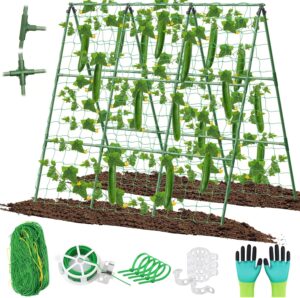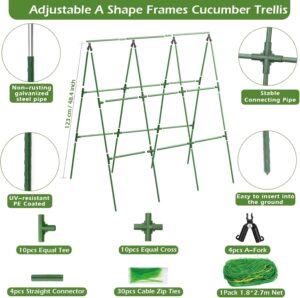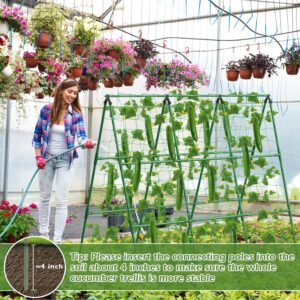Unlock the Secrets to Bountiful Cucumber Harvests in Soil Bags at Home

Discover the Incredible Benefits of Growing Cucumbers
Cucumbers are a versatile and nutritious addition to any home garden. Not only do they provide a refreshing crunch and a host of health benefits, but they are also surprisingly easy to grow – even in small spaces. In this comprehensive guide, we’ll explore the step-by-step process of cultivating a thriving cucumber crop using soil bags, allowing you to enjoy a bountiful harvest right from the comfort of your own backyard or patio.
Cucumbers are packed with essential vitamins, minerals, and antioxidants that offer a wide range of health advantages. They are low in calories, high in water content, and rich in nutrients like vitamin C, vitamin K, magnesium, and potassium. Regularly incorporating cucumbers into your diet can help reduce inflammation, aid in weight management, and even provide protection against certain types of cancer. With their refreshing flavor and crunchy texture, cucumbers are a must-have for any health-conscious household.
The Benefits of Growing Cucumbers in Soil Bags
While traditional in-ground gardening is a popular option, growing cucumbers in soil bags offers several unique advantages. Soil bags are a versatile and space-saving solution, making them an ideal choice for small gardens, patios, or even balconies. By utilizing soil bags, you can easily control the growing environment, ensuring your cucumbers receive the optimal conditions for thriving.
One of the key benefits of using soil bags is the ability to create the perfect soil mix for your cucumbers. Cucumbers thrive in well-draining, nutrient-rich soil, and soil bags allow you to customize the soil composition to meet their specific needs. This can lead to healthier plants, more robust root systems, and ultimately, a more abundant harvest.
Additionally, soil bags can help protect your cucumbers from pests and diseases that may be present in your local soil. By using a fresh, high-quality soil mix, you can minimize the risk of soil-borne issues and ensure your cucumbers grow strong and vibrant.
Preparing the Soil Bags for Cucumber Planting
To get started, you’ll need to select the right soil bags for your cucumber growing project. Look for bags that are specifically designed for vegetable gardening, as they will typically contain a blend of nutrient-rich soil, compost, and other amendments to support healthy plant growth.
When choosing the size of your soil bags, consider the mature size of your cucumber plants. Larger bags, such as those with a capacity of 20-30 gallons, will provide ample room for the roots to spread and the plants to thrive. If you have limited space, you can opt for smaller 10-15 gallon bags, but keep in mind that you may need to water and fertilize more frequently.
Before planting, it’s important to prepare the soil bags by loosening the soil and incorporating any additional amendments, such as compost or slow-release fertilizer. This will ensure your cucumbers have access to the nutrients they need for robust growth and abundant fruit production.

Sowing Cucumber Seeds and Transplanting Seedlings
When it comes to growing cucumbers in soil bags, you have two options: starting from seed or transplanting seedlings. Both methods can be successful, but starting from seed may provide you with more control over the growing process.
To sow cucumber seeds, plant them about 1 inch deep and 12 inches apart in the soil bags. Water the soil gently, and keep it consistently moist until the seeds germinate, which typically takes 7-10 days. Once the seedlings emerge, thin them out to the strongest plants, leaving about 18-24 inches between each one.
If you prefer to use seedlings, you can purchase them from a local nursery or start them indoors a few weeks before your desired planting time. When transplanting the seedlings, be sure to handle them gently and plant them at the same depth they were growing in their previous containers. Water the soil thoroughly after transplanting to help the roots establish.
Providing the Right Growing Conditions
Cucumbers thrive in warm, sunny conditions, so it’s important to choose a spot that receives at least 6-8 hours of direct sunlight per day. If you’re growing your cucumbers in a shaded area, you may notice reduced growth and lower fruit production.
Maintaining consistent soil moisture is also crucial for cucumber plants. Water the soil bags regularly, keeping the soil moist but not waterlogged. Aim to water in the morning or evening to minimize evaporation, and adjust your watering schedule as needed based on weather conditions and plant growth.
To support the vining nature of cucumber plants, consider using a trellis or other vertical structure. This not only helps to keep the plants off the ground, but it also promotes better air circulation and can lead to straighter, more uniform fruit. You can easily create a simple trellis using wire or bamboo stakes, and train the cucumber vines to climb as they grow.

Pruning and Pollination for Maximum Fruit Production
Proper pruning and pollination techniques can significantly boost your cucumber harvest. As your plants begin to mature, look for the appearance of the first female flowers, which will have a small cucumber-shaped ovary behind the blossom. Once you see these, it’s time to start pruning.
Prune the plant by removing any flowers or fruit that appear on the first 5-6 nodes (the point where the leaf stems attach to the main vine). This encourages the plant to focus its energy on developing stronger vines and larger, more abundant fruit further up the plant.
Pollination is also crucial for cucumber production. While cucumbers can self-pollinate, you can help the process along by hand-pollinating the flowers. Simply use a small paintbrush or cotton swab to transfer pollen from the male flowers (which have no ovary) to the female flowers. This ensures that the female flowers are properly fertilized, leading to the development of more cucumbers.
Harvesting and Storing Your Cucumber Bounty
Patience and vigilance are key when it comes to harvesting your cucumbers. Keep a close eye on your plants, and start checking for mature fruit about 50-70 days after planting. Cucumbers are ready to harvest when they are 6-8 inches long and have a deep green color, with no yellowing or blemishes.
To harvest, simply use a sharp knife or scissors to cut the cucumber from the vine, leaving a short stem attached. Avoid pulling or twisting the fruit, as this can damage the plant. Regularly harvesting your cucumbers will encourage the plant to continue producing more fruit throughout the growing season.
Once harvested, cucumbers can be stored in the refrigerator for up to a week. For longer-term storage, you can pickle, can, or freeze your excess cucumbers to enjoy them year-round. With proper storage and preservation techniques, you can savor the fresh, crisp flavor of your homegrown cucumbers long after the growing season has ended.
Troubleshooting Common Cucumber Growing Challenges
- Yellowing Leaves: This can be a sign of over watering, nutrient deficiency, or disease. Adjust your watering schedule and consider adding a balanced fertilizer to the soil.
- Powdery Mildew: This fungal disease can cause white, powdery spots on the leaves. Treat with a fungicide or a baking soda solution, and ensure good air circulation around the plants.
- Cucumber Beetles: These pests can damage the leaves, stems, and fruit. Use row covers or organic insecticidal sprays to deter them.
- Bitter Fruit: Excessive heat, stress, or nutrient imbalances can cause cucumbers to develop a bitter taste. Ensure consistent watering and soil fertility to prevent this issue.



